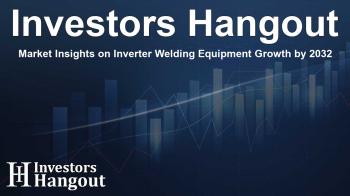Market Insights on Inverter Welding Equipment Growth by 2032

Inverter Welding Equipment Market Overview
As industries across the globe strive for increased efficiency and sustainability, the Inverter Welding Equipment Market is set to experience substantial growth. Current projections estimate that this market could grow from USD 5.32 billion in 2024 to around USD 8.63 billion by 2032, showcasing a compound annual growth rate (CAGR) of 6.24% from 2025 to 2032. This promising trend is driven by heightened demand for automated and energy-efficient welding solutions across various sectors including automotive, aerospace, and construction.
The Rise of Energy-Efficient Solutions
The demand for inverter-based welding solutions stems largely from their ability to offer enhanced precision, reduce emissions, and support smart technology integration. These systems not only cater to mass production but also meet the specific needs of specialized applications. The integration of Internet of Things (IoT) and Artificial Intelligence (AI) technologies significantly improves operational efficiency, aligning with the global trend towards decarbonization.
Market Growth in the U.S.
The U.S. inverter welding equipment market is predicted to grow from USD 0.97 billion in 2024 to USD 1.62 billion by 2032, driven by the need for lightweight, portable welding solutions. Growing applications within the automotive and aerospace sectors are significant contributors to this growth, highlighting the shifting focus towards smart automation in these industries. Inverter welders stand out for their ability to lower energy consumption while delivering precise results, thus supporting sustainable industrial practices.
Leading Players in the Market
Key players in the Inverter Welding Equipment Market include industry leaders such as ESAB, Fronius International GmbH, Kemppi Oy, Panasonic Industry Co. Ltd., Ador Welding Limited, The Lincoln Electric Company, Migatronic A/S, GYS, Miller Electric Mfg. LLC, and voestalpine Böhler Welding Group GmbH. These companies are driving innovations that enhance product performance and address the evolving needs of various sectors.
Segment Analysis
By Type
The Mechanized Arc Welding segment is currently the largest segment, commanding around 80% share of the market in 2024. This widespread application reflects its crucial role in high-performance industries, where consistency and reliability are paramount. Automating arc welding systems allows for enhanced efficiency and quality, making them suitable for mass production scenarios.
By Power Supply
The 1-phase power supply segment leads the market with a 58% share. Its popularity arises from its ease of availability, lower installation costs, and suitability for small to mid-scale projects, making it ideal for workshops and light industry. This adaptability supports a growing trend towards using inverter welding machines in both residential and commercial applications.
By End-Use
The aerospace sector leads in market share with over 32% in 2024. Welding systems in this domain are required to meet stringent standards for precision and quality, as lightweight and structurally sound components are vital in aviation manufacturing. The global increase in aircraft production and maintenance activities further propels growth in this segment.
Regional Market Insights
Asia-Pacific dominates the inverter welding equipment market, bolstered by rapid industrial expansion and government initiatives aimed at infrastructure development. Countries such as China, India, and Japan are at the forefront, supported by a large manufacturing base and skilled workforce. North America, meanwhile, emerges as the fastest-growing market, influenced by advancements in automation, stringent environmental regulations, and increased investment in smart technologies.
The adoption of innovative welding technologies not only aligns with improving productivity but also enhances competitiveness in a fast-evolving market landscape.
Frequently Asked Questions
What is driving the growth of the Inverter Welding Equipment market?
The growth is primarily fueled by the increasing demand for energy-efficient and automated welding solutions across various industries.
Which sectors are leading in inverter welding technology?
The aerospace and automotive sectors are among the leading industries utilizing inverter welding technology due to their need for precision and efficiency.
How does inverter welding enhance sustainability?
Inverter welding systems reduce energy consumption and emissions, making them a more environmentally friendly option compared to traditional welding methods.
Who are the key players in the Inverter Welding Equipment market?
Major players include ESAB, Fronius International GmbH, Kemppi Oy, and The Lincoln Electric Company, among others.
What geographical trends are emerging in this market?
Asia-Pacific is currently the largest market, while North America is the fastest-growing region, driven by technological advancements and regulatory pressures for sustainability.
About The Author
Contact Logan Wright privately here. Or send an email with ATTN: Logan Wright as the subject to contact@investorshangout.com.
About Investors Hangout
Investors Hangout is a leading online stock forum for financial discussion and learning, offering a wide range of free tools and resources. It draws in traders of all levels, who exchange market knowledge, investigate trading tactics, and keep an eye on industry developments in real time. Featuring financial articles, stock message boards, quotes, charts, company profiles, and live news updates. Through cooperative learning and a wealth of informational resources, it helps users from novices creating their first portfolios to experts honing their techniques. Join Investors Hangout today: https://investorshangout.com/
The content of this article is based on factual, publicly available information and does not represent legal, financial, or investment advice. Investors Hangout does not offer financial advice, and the author is not a licensed financial advisor. Consult a qualified advisor before making any financial or investment decisions based on this article. This article should not be considered advice to purchase, sell, or hold any securities or other investments. If any of the material provided here is inaccurate, please contact us for corrections.

